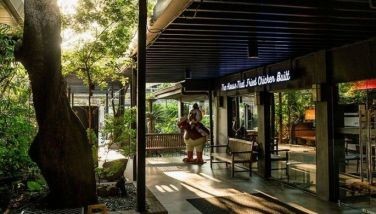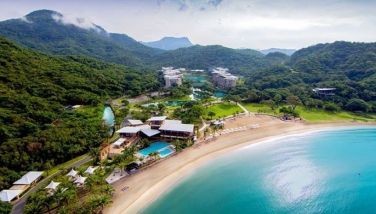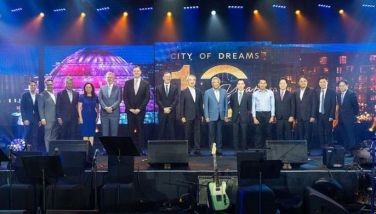Full moon at midnight in the morning of the world

UBUD, Bali — Waking up in the world’s morning with half an hour to spare before noon, I stumble down a few steps from the resort cottage and am greeted by sunlight dappling the greenery, the garden sentinels that are stone carvings of Buddha, reclining lions, and bare-breasted Mother Earth figures, and the jacuzzi and infinity pool rimmed by a valley view of rice terraces and extensive coconut stands.
Familiar as home are the floral disarrangements: a profusion of bougainvillea, hibiscus, heliconias, anthuriums, crotons, ti plants, yellow bell vine crowning bamboo latticework, frangipani, a lone mango tree with a lone green fruit near to maturing and hanging low — except it isn’t wrapped in newspaper but only partially sheathed in a styrofoam web. Butterflies flit into the picture; again the welcome is intimate.
One marked difference, something not commonly done for the Pinoy habitat, is the daily proffer of blooms set on a small square box of palm weave that’s left just outside a door. I almost step on this version of a welcome mat, woozy at the high hour because I’ve just spent my first night (from four a.m. up) on a large four-poster with bolts of cream cloth, one heavy, one gauzy, draped on its corners.
Could be for protection against mosquito bites, or simply part of the atmospheric flavor, such as dim lights everywhere you go: your room, the patio with the bar, any resto, the streets and paths everywhere, even the temple courtyards and inner sanctums.
New arrivals often remark that either the Balinese are such energy conservationists that no one uses anything brighter than a 25-watt incandescent bulb, or it’s all an effort to retain the old ways of “night-filled homes” — as the Chinese poet Li Po would have put it.
From the airport at Denpasar, one is greeted by all the familiar elements of street life in Bali: low-slung red brick walls surrounding temples, rotunda monuments to gods and heroes (with mythic white stallions pulling a chariot manned by Arjuna’s brother Bima), a sudden mosque with its blinding white onion dome, stupas, pitched roofs of red tiles, chichirica on the sidewalk cracks, competing with sundry bushes, palms, bananas, plane trees, acacias, bauhinias, neem and Indian trees on the streets’ center islands...
Bamboo poles rise 10 meters high before they curve down gracefully with the weight of ornamental cloth or woven boxes rife with trimmings. It’s all a joyous affair, this entry into town. Colorful banners and streamers are everywhere, a few demanding that you “Learn English!” — while signs announce mini marts and Internet before the first McDo and Dunkin’ Donuts marquees join the commercial fray some five kilometers in.
From the airport egress, too, ubiquitous tarp streamers proclaim the 1st Asian Beach Games from Oct. 18 to 26. But that’s not why I’m here — since beachcombing still has to become a sporting event. In fact I probably won’t hit a beach for sometime, as the fifth Ubud Writers and Readers Festival takes place inland, somewhat upland, in the famed artists’ village of Ubud and its environs — where the accommodations all offer backdoor views of river gullies and terraced valleys from the dominating ridge close to the narrow main road.
I check in at Sayan Terrace Resort and appreciate the large cottage room that can fit a party of 20 seamen, five on the two beds and the rest on the floor. Upstairs is where fellow writer-guest Shelley Kenigsberg from Sydney is billeted, with a gecko that clucks on the hour. We appreciate the back-garden sunset view and walk up the main road to get to Four Seasons Resort, where the welcome cocktails for participants and media are held on an elegant terrace that seems to float on a lotus pond.
The full moon rises beyond the forested ridge as dusk sets in. It is the Hunter’s Moon, as I’d been told by poet Marj Evasco, who’d been here before, and who had also advised that the special moonrise would best be viewed from the mother of all Bali temples at Besakih.
But the cocktails and subsequent dinner must preempt that. “No way you can get to Besakih and back in time,” wrote festival program manager Catriona Mitchell, “as it’s a 90-minute drive from Ubud.” She offers an alternative.
“However, the best time to see some of the mountain temples in Bali is at midnight under the full moon. It just so happens that our Indonesian program coordinator (Krishna Kadek) will be going to his ancestral home in Kintamani, site of the Batur temple, the second largest temple complex in Bali, after the dinner on Tuesday the 14th of October. It’ll only be a 30-minute drive from Ubud, and he can return you to your hotel. Please bring a warm coat because it gets cold at 1,500m above sea level!”
Sounds exciting, I thought. I was also told to wear a white shirt, and they’d just lend me a sarong and head sash for the temple visit.
True enough, after dinner at The Mansion, where I’m delightfully surprised with the presence of old friends from Baguio — Jojo Laurel and Yago Laudico (who tell me that writer-gourmand Laida Lim, her daughter Feliz and sister Linda are also around as festival “friends”) — Kris rounds up a few other writers for the midnight tour of the Batur temples.
Faith Adiele of the USA but of Nigerian-Finnish heritage (and a memoirist on becoming Thailand’s first black Buddhist nun), Chinese writer-journalist Lijia Zhang, and Festival moderator Shalini Giddomai of Kenya pile up with us in a small SUV.
A pretty face of old also shows up at the dinner: bestselling novelist Ayu Utami, with whom I had paneled in a literary erotica discussion in the Hong Kong writers’ fest of February 2007. She and her young media friends from Jakarta decide to convoy with us to Kintamani.
At the promised elevation, mist welcomes our two-car party after an hour of trailing lorries up the narrow, winding road. We park at roadside, fix up our sarongs, and enter the Balinese temple complex, where sleep-ins of dozens of devotees are in progress on some open-sided huts, and other latecomers walk in, too, for prayers inside the sanctum areas we’re not allowed to enter.
It’s a grand festival week in October all over Bali and Ubud. On our drive up, many times did we have to slow down before throngs of men huddled together in uniform attire, waiting to cross the road and be accommodated for rites inside smaller temples. Shalini recounts how she had trekked up to a mountain temple the day before, alongside thousands of prayerful Balinese, with the women balancing a babi guling or suckling pig each on their heads.
Inside the Batur temples, the pork becomes part of the votive offerings of flower and fruit arrangements. Here they’re called babi pregembal — large hogs whose heads and trotters are highlights of the decorations for big ceremonies.
The full moon weaves its way past the spires and colorful long spears left leaning on century-old brick walls. We make our way down to Sayan well past 1 a.m., and find ourselves having to trail a procession of temple-goers across a fairly large town. The women balance stacks of fruit offerings on their heads as they peel off for home. We can’t overtake the gamelan orchestra at the head of the parade, and have to content ourselves with a back route when we chance on an intersection.
That is why my first night lasts till close to dawn (especially since the resort has WiFi, another delight other than the nearly al fresco toilet and shower stall).
Wednesday afternoon, I gather my faith and lounge in the pool, missing out on the writers lunch at Kupu Kupu Barong, until it’s time to go downtown for the gala festival opening at Ubud Palace, with festival director Janet De Neefe and the Governor of Bali delivering the main speeches.
Another “old Asia hand” and familiar face is that of Tony Wheeler, the Lonely Planet books pioneer-turned-magnate, who will be conducting a full day’s tour of rice fields, with expert commentary. We reintroduce ourselves after nearly three decades. In the early 1980s, I had “guided” the young backpacker Tony (then just starting out on his first Lonely Planet guidebook) through Ermita and Malate, so he could contribute a fresh eye to the second edition of APA Insight Guide to the Philippines.
At the Palace, all the stops are pulled out for a spectacular, cast-of-hundreds Balinese dance production, with an entire crew of gods and heroes, villains, monkeys, tigers and dragons shimmering in resplendent costumes, backed by a full gamelan orchestra.
At the gala dinner at Casa Luna, Laida and company join my table, along with Faith and Shalini. We exchange calendars over Jacob’s Creek red wine and more of that babi guling or lechon, sans our sweetish liver sauce but with a curdled mix of spices.
I am scheduled to join the Poetry & Afternoon Tea program at photographer Rio Helmi’s residence the next day, which is capped by performance poetry and comedy skits at the Jazz Cafe. Then I conduct a three-hour Poetry & the Moon Workshop at Casa Luna on Friday morning, join the Carnival Street Party on Saturday, and the Nature & Writing panel discussion on Sunday, before the Closing Night Party at Antonio Blanco Renaissance Museum.
Meanwhile, on off hours, there’s that infinity pool at Sayan to lave in, and a bottle of Bowmore 12-year-old single malt from Islay in the Hebrides to break — on a garden terrace in this counterpart of a magical island.
Hey, it feels good to be just one of the 208 participating writers in what has been hailed, by Harper’s Bazaar, UK, as “One of the top six writing festivals in the world!” — where it’s ever morning in the planet’s very navel.



















